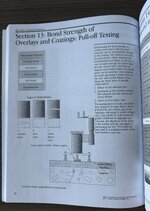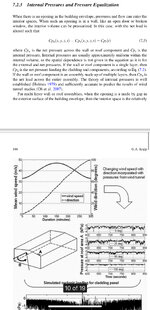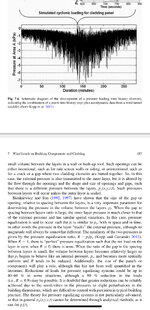I've got some concrete projects in a high wind area (~170mph and exp D). The roofs were supposed to be monolithically pitched to drains. The contractor built them flat and wants to pour a topping slab to achieve the slope. Unless I'm missing something this does not appear to work w/out a silly amount of concrete. Uplift pressures are 100 to 200psf depending on the zone. I have of course gotten the response of 'we always do this' but I'm not seeing how it works short of drilling/epoxying dowels in to tie it down. Am I missing something and there's a rational way to make this work, short of tying it down?
Navigation
Install the app
How to install the app on iOS
Follow along with the video below to see how to install our site as a web app on your home screen.
Note: This feature may not be available in some browsers.
More options
Style variation
-
Congratulations dmapguru on being selected by the Eng-Tips community for having the most helpful posts in the forums last week. Way to Go!
You are using an out of date browser. It may not display this or other websites correctly.
You should upgrade or use an alternative browser.
You should upgrade or use an alternative browser.
Roof Topping Slab in High Wind
- Thread starter bookowski
- Start date
- Status
- Not open for further replies.
EZBuilding
Structural
Is it the intent for the topping slab to be typical structural concrete?
I would recommend taking at look at Miami Dade County's NOA's which are local to Florida's High Velocity Hurricane Zones which identifies additional standards for enclosure elements. In South Florida, Light-Weight Insulating Concrete on Rigid Insulation covered by a roofing membrane is a very common type of roof installation. The topping slab there tends to be considered as part of the "roofing-system" and the NOA would provide the testing data that defines that the system can withstand the wind pressures. For the case of the light-weight insulating concrete, it is either adhered or fastened to the substructure.
Following link found through googling:
I would recommend taking at look at Miami Dade County's NOA's which are local to Florida's High Velocity Hurricane Zones which identifies additional standards for enclosure elements. In South Florida, Light-Weight Insulating Concrete on Rigid Insulation covered by a roofing membrane is a very common type of roof installation. The topping slab there tends to be considered as part of the "roofing-system" and the NOA would provide the testing data that defines that the system can withstand the wind pressures. For the case of the light-weight insulating concrete, it is either adhered or fastened to the substructure.
Following link found through googling:
From what I understand, roof "uplift" is from the air moving fast across the roof, and the internal pressure of the building being higher (similar to how an airplane wing generates lift, with a high pressure zone below and a low pressure above). So your wind uplift is less the wind "picking up" the topping and more pushing from below. I'm not sure exactly what the proportions if upward pressure and outward suction would be on a roof, but its not like the wind is picking it up, since there isn't a gap below the topping and the roof for a high-low pressure zone to form.
EZBuilding
Structural
So your wind uplift is less the wind "picking up" the topping and more pushing from below.
That used to be my understanding, but that has wavered over the past couple of years.
Certainly in South Florida, the standard of care is to apply the ASCE 7-XX provisions for wind uplift for all elements of the roofing assembly.
HDStructural
Structural
My understanding is that the internal pressure coefficient relates to upward pressure from the inside and the remaining pressure is from outward suction. I would expect the majority of wind pressure to be considered outward suction.
I agree with OP's concerns. The topper would need to be somehow tied down to resist the net uplift acting on it.
I agree with OP's concerns. The topper would need to be somehow tied down to resist the net uplift acting on it.
- Thread starter
- #6
@EZB - I recommended the LWIC as my first response, they want to use standard concrete. I don't have experience with LWIC but I had looked into it and it seems that it gets its its resistance through bonding to the slab as you said. I am ok with this system, but this is what they're trying to avoid.
@EngDM - I went down the same thought process at first, but I am not confident that I can hang my hat on that or tease out some minimal suction. And if there is any air leak is it binary and suddenly I get the full pressure, allowing the system to "unzip" as more and more air gets in? I'd follow this route if I could find some better documentation on it but everything I've found recommends to treat the roofing system with the wind uplift pressures.
@EngDM - I went down the same thought process at first, but I am not confident that I can hang my hat on that or tease out some minimal suction. And if there is any air leak is it binary and suddenly I get the full pressure, allowing the system to "unzip" as more and more air gets in? I'd follow this route if I could find some better documentation on it but everything I've found recommends to treat the roofing system with the wind uplift pressures.
EZBuilding
Structural
There is probably an answer for bonding of the new structural topping concrete slab to the existing structural slab out there somewhere, but it may require a good chunk of research and follow-through on your end to get comfortable with it. If you do end up pursuing that, please follow up and share where you ended up.@EZB - I recommended the LWIC as my first response, they want to use standard concrete.
My understanding is that the internal pressure coefficient relates to upward pressure from the inside and the remaining pressure is from outward suction. I would expect the majority of wind pressure to be considered outward suction.
I went down the same thought process at first, but I am not confident that I can hang my hat on that or tease out some minimal suction. And if there is any air leak is it binary and suddenly I get the full pressure, allowing the system to "unzip" as more and more air gets in? I'd follow this route if I could find some better documentation on it but everything I've found recommends to treat the roofing system with the wind uplift pressures.
I've heard the argument to exclude the interior CPI as part of the calculations for the roofing system and it seems reasonable. I've heard the argument that the roofing system never "sees" the pressure as it is all provided due to the "push" of the pressure difference and not from a pull of the exterior outward suctions. I agree that I haven't found any good documentation that describes this.
I think there was some decent discussion on there a while back on wind suction and whether it acts on "inside" or "outside" surfaces of a system. It seems to me that I was convinced by a sketch/general statics that all roof suction must be driven by a pressure difference (except maybe for the case of wind blowing up and under plys of roofing or something similar) and would act at the inside surface of a system. It may be worth a look back. Maybe there has been some recent code wording or publications that has convinced EZBuilding and bookowski.
I have not had to dig into this for a while, but am interested in what is decided. For roofing components like membranes, metal roofing, and possibly even sheet goods, I can see some local wind getting "up and under" components and casing separation of the system, but for something like a concrete topping layer, I see this as being much less likely. While it may be a good idea to adhere the layers nominally, designing this positive connection between layers for full wind uplift using low area C&C wind may not be completely necessary
Also - 200 psf uplift seems insane, even for 170mph exp D. I hope/assume that is an ultimate load. This is going to take alot of ballast to hold down. I hope the gravity resisting system will work for the "extra" concrete
I have done roofs with topping slab ballast to help limit uplift of the system, both with concrete and with "insulating concrete" . Ballast concrete was anchored to main structure in both cases, but I am not sure I was dealing with wind loads as high as you reference above.
I have not had to dig into this for a while, but am interested in what is decided. For roofing components like membranes, metal roofing, and possibly even sheet goods, I can see some local wind getting "up and under" components and casing separation of the system, but for something like a concrete topping layer, I see this as being much less likely. While it may be a good idea to adhere the layers nominally, designing this positive connection between layers for full wind uplift using low area C&C wind may not be completely necessary
Also - 200 psf uplift seems insane, even for 170mph exp D. I hope/assume that is an ultimate load. This is going to take alot of ballast to hold down. I hope the gravity resisting system will work for the "extra" concrete
I have done roofs with topping slab ballast to help limit uplift of the system, both with concrete and with "insulating concrete" . Ballast concrete was anchored to main structure in both cases, but I am not sure I was dealing with wind loads as high as you reference above.
1-2ft of concrete resists that uplift with weight alone.
That’s unreasonable, so you’ll need to supplementally rely on tensile bond strength.

Lots of misinformation about wind in this thread. ASCE 7 idealizes net upward wind pressure as the sum of pressures developed externally and internally. Even with a perfectly sealed building, such that no air leaks in or out, there will still be uplift. Airplane wings are airfoils. Buildings are bluff bodies.
I suggest that you throw this problem into the Architect’s lap, if you can. As others have mentioned, adhered roof membranes are often tested as a system, so an architect can figure out if any include a bonded overlay.
That’s unreasonable, so you’ll need to supplementally rely on tensile bond strength.

Lots of misinformation about wind in this thread. ASCE 7 idealizes net upward wind pressure as the sum of pressures developed externally and internally. Even with a perfectly sealed building, such that no air leaks in or out, there will still be uplift. Airplane wings are airfoils. Buildings are bluff bodies.
I suggest that you throw this problem into the Architect’s lap, if you can. As others have mentioned, adhered roof membranes are often tested as a system, so an architect can figure out if any include a bonded overlay.
I agree. In my post above, outside of a caveat for small components that may actually see wind under individual components ex. a single or breached membrane, I was stating that there is no air in or out - which results in a net pressure difference. I think there is an augment that a pressure gradient resulting in uplift would act on the "inside" surface of the building.ASCE 7 idealizes net upward wind pressure as the sum of pressures developed externally and internally. Even with a perfectly sealed building, such that no air leaks in or out, there will still be uplift. Airplane wings are airfoils. Buildings are bluff bodies.
This may have been the post I was remembering, but I think there is another around here somewhere that includes some nice little sketches.
A question on "suction", ASCE 7, ICC 500, storm shelters. - Structural engineering general discussion
I've been a lurker for years, but the issue at hand has me so turned around I finally decided to make an account and post the question. I'm hoping that the intelligence of the masses can help me out. Here is the issue: I work for a precast designer and supplier that was asked by an EOR what the...
In practice I have not found much information on the application of wind suction and have generally been a voice for adhering ballast layers to roofs, however I do think there is some merit to the argument that some significant component of wind uplift - maybe even all of it - acts at the underside of the roof assembly.
Thanks for the reference ANE91. This is better information than most I have seen.
I have mostly chalked this issue up to the following:
- We are not quite sure how wind suction is applied across multiple layers - It is likely a combination of internal pressure differences, pressure difference across layers, and wind drag across components.
- In light of this - where practical we should design attachments of components/layers for the full wind uplift pressures.
- Where this is not practical (or ideal), it may be justifiable to back out some portion of the wind as being caused by internal pressure only and thus acting on the inside surface of the assembly (GCpi). This may be significant for partially enclosed structures and storm shelters.
I have mostly chalked this issue up to the following:
- We are not quite sure how wind suction is applied across multiple layers - It is likely a combination of internal pressure differences, pressure difference across layers, and wind drag across components.
- In light of this - where practical we should design attachments of components/layers for the full wind uplift pressures.
- Where this is not practical (or ideal), it may be justifiable to back out some portion of the wind as being caused by internal pressure only and thus acting on the inside surface of the assembly (GCpi). This may be significant for partially enclosed structures and storm shelters.
TRAK.Structural
Structural
I second the suggestion of pull-of testing that is done for overlays. You get real data from the actual installers with the actual products. You could also potentially ask for an extended warranty from the contractor just so he/she has some extra skin in the game.
You are aware that there is no such force as "outward suction"?My understanding is that the internal pressure coefficient relates to upward pressure from the inside and the remaining pressure is from outward suction. I would expect the majority of wind pressure to be considered outward suction.
I agree with OP's concerns. The topper would need to be somehow tied down to resist the net uplift acting on it.
That is just a relabelling of the drop in atmospheric pressure on the exterior.
HDStructural
Structural
That term was used earlier in this thread by EngDM, so I repeated the term. My point is that there is pressure on the wall that is applied from the exterior, and not all from the interior.
Exactly, so then the drop in atmospheric is then pushed up from the bottom no? The wind isn't "grabbing" the topping, but the pressure difference is pushing it up from the high pressure area to the low pressure.You are aware that there is no such force as "outward suction"?
That is just a relabelling of the drop in atmospheric pressure on the exterior.
If we instead think of a ballasted roof, do the individual stones ever get picked up? No (maybe they get pushed around laterally since they aren't one solid material). So I'm having a hard time believing that the topping is going to lift independant of the roof.
HDStructural
Structural
Why is there uplift on an open building with a perfectly flat roof? There isn't a change in atmospheric pressure from below the roof to above it.
For a leeward wall, there is a suction effect of sorts on the outside of the wall due to vortex shedding. Not sure if that would also apply on a roof.
For a leeward wall, there is a suction effect of sorts on the outside of the wall due to vortex shedding. Not sure if that would also apply on a roof.
- Status
- Not open for further replies.
Similar threads
- Replies
- 8
- Views
- 3K
- Replies
- 8
- Views
- 9K
- Replies
- 5
- Views
- 8K
- Question
- Replies
- 1
- Views
- 4K


